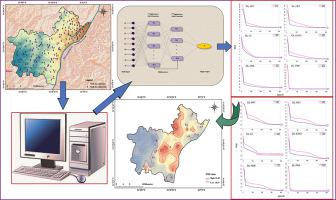Journal of Contaminant Hydrology ( IF 3.5 ) Pub Date : 2020-09-23 , DOI: 10.1016/j.jconhyd.2020.103718 Sudhakar Singha , Srinivas Pasupuleti , Soumya S. Singha , Suresh Kumar

|
Globally, groundwater heavy metal (HM) pollution is a serious concern, threatening drinking water safety as well as human and animal health. Therefore, evaluation of groundwater HM pollution is essential to prevent accompanying hazardous ecological impacts. In this aspect, the effectiveness of various groundwater HM pollution evaluation approaches should be examined for their level of trustworthiness. In this study, 226 groundwater samples from Arang of Chhattisgarh state, India, were collected and analyzed. Measured concentration for various HMs were further used to calculate six groundwater pollution indices, such as the HM pollution index (HPI), HM evaluation index (HEI), contamination index (CI), entropy-weight based HM contamination index (EHCI), Heavy metal index (HMI), and principal component analysis–based metal index (PMI). Groundwater in the study area was mainly contaminated by elevated Cd, Fe, and Pb concentrations due to natural and anthropogenic pollution. Moreover, this study explored the performance of deep learning (DL)-based predictive models via comparative study. Two hidden layers with 26 and 19 neurons in the first and second hidden layers, respectively, were optimised along with rectified linear unit activation function. A mini-batch gradient descent was also applied to ensure smooth convergence of the training dataset into the model. Results demonstrated that the DL-PMI scored lowest errors, 0.022 for mean square error (MSE), 0.140 for mean absolute error (MAE), and 0.148 for root mean square error (RMSE), in the model validation than the other DL-based groundwater HM pollution model. Prediction performances of all pollution indices were also verified using artificial neural network (ANN)-based models, which also highlighted the lowest validation error for ANN-PMI (MSE = 3.93, MAE = 1.38, and RMSE = 1.98). Furthermore, the prediction accuracies of PMI using both ANN and DL models scored the highest R2 value of 0.95 and 0.99, respectively. Therefore it is suggested that groundwater HM pollution using PMI as the best indexing approach in the present study area. Moreover, compared to benchmark, ANN, the DL performed better; hence, it could be concluded that the proposed DL model may be suitable approach in the field of computational chemistry by handling overfitting problems.
中文翻译:

深度学习研究地下水重金属污染指数的有效性
在全球范围内,地下水重金属(HM)污染是一个严重的问题,威胁到饮用水安全以及人类和动物健康。因此,评估地下水HM污染对于防止伴随的有害生态影响至关重要。在这方面,应检查各种地下水HM污染评估方法的可信度。在这项研究中,收集并分析了来自印度恰蒂斯加尔邦Arang的226个地下水样品。各种HM的测量浓度进一步用于计算六种地下水污染指数,例如HM污染指数(HPI),HM评价指数(HEI),污染指数(CI),基于熵权的HM污染指数(EHCI),重金属指数(HMI)和基于主成分分析的金属指数(PMI)。由于自然和人为污染,研究区的地下水主要被Cd,Fe和Pb浓度升高污染。此外,本研究通过比较研究探索了基于深度学习(DL)的预测模型的性能。优化了第一隐藏层和第二隐藏层中分别具有26和19个神经元的两个隐藏层,以及经过校正的线性单位激活函数。还应用了小批量梯度下降以确保训练数据集平稳收敛到模型中。结果表明,在模型验证中,与其他基于DL的基于DL的PMI相比,DL-PMI的最低错误,均方误差(MSE)为0.022,平均绝对误差(MAE)为0.140和均方根误差(RMSE)为0.148。地下水HM污染模型。还使用基于人工神经网络(ANN)的模型验证了所有污染指数的预测性能,该模型还强调了ANN-PMI的最低验证误差(MSE = 3.93,MAE = 1.38和RMSE = 1.98)。此外,使用ANN和DL模型的PMI预测准确性得分最高2值分别为0.95和0.99。因此,建议在本研究区中以PMI作为最佳指标化方法对地下水HM污染进行研究。此外,与基准ANN相比,DL表现更好;因此,可以得出结论,通过处理过拟合问题,提出的DL模型在计算化学领域可能是合适的方法。











































 京公网安备 11010802027423号
京公网安备 11010802027423号